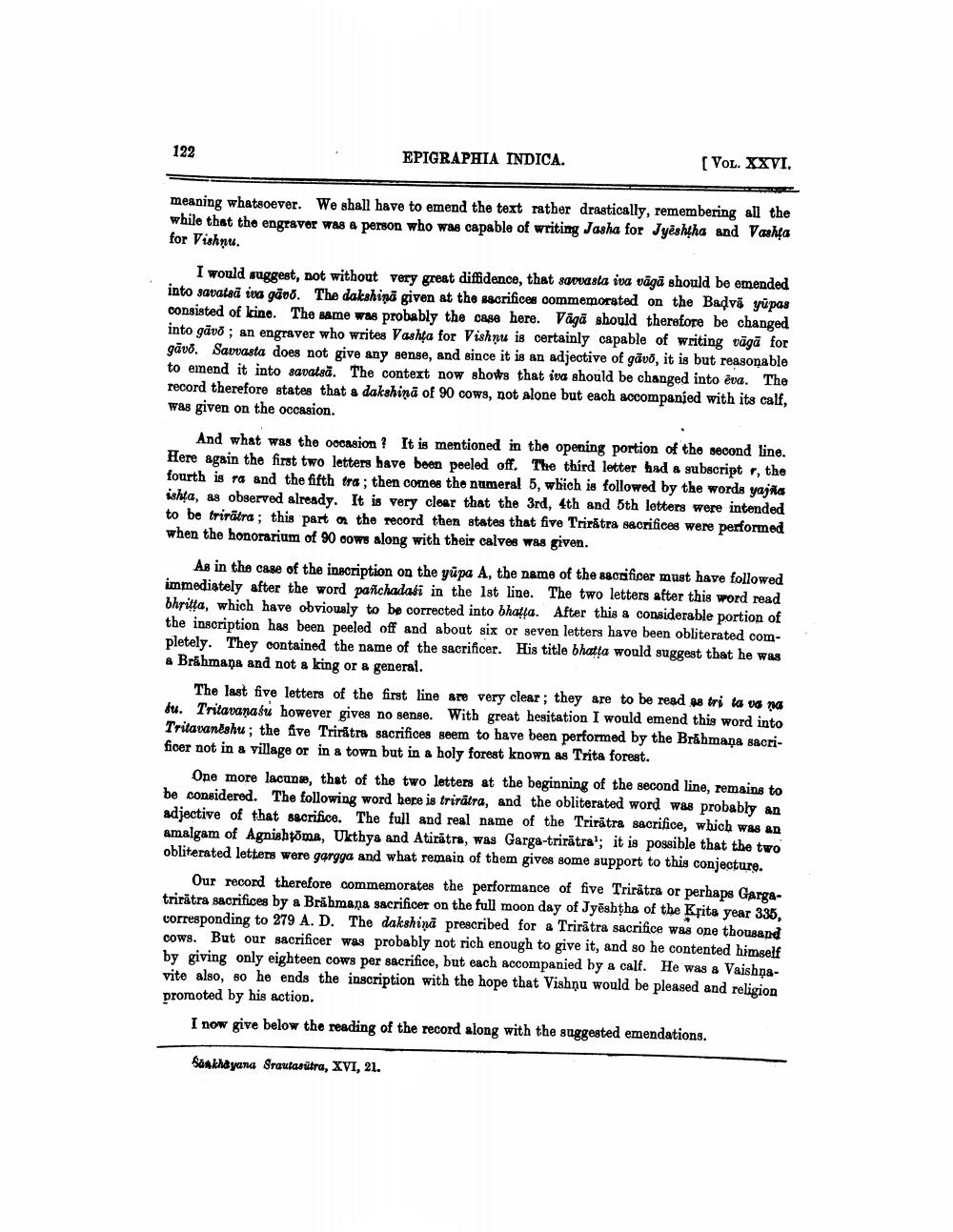________________
122
EPIGRAPHIA INDICA.
(VOL. XXVI.
meaning whatsoever. We shall have to emend the text rather drastically, remembering all the while that the engraver was a person who was capable of writing Jasha for Jyēshtha and Vashta for Vishnu.
I would suggest, not without very great diffidence, that savvasta iva vāgā should be emended into savatsā ina gāvo. The dakshinā given at the sacrifices commemorated on the Badvi yupas consisted of kine. The same was probably the case here. Vāgā should therefore be changed into gāvd ; an engraver who writes Vashta for Vishnu is certainly capable of writing vägā for gāvo. Savvasta does not give any sense, and since it is an adjective of gāvo, it is but reasonable to emend it into savatsā. The context now shows that iva should be changed into eva. The record therefore states that a dakshina of 90 cows, not alone but each accompanied with its calf, was given on the occasion.
And what was the occasion ? It is mentioned in the opening portion of the second line. Here again the first two letters have been peeled off. The third letter had & subscript r, the fourth is ra and the fifth tra; then comes the numeral 5, which is followed by the words yajña ishta, as observed already. It is very clear that the 3rd, 4th and 5th letters were intended to be trirātra ; this part on the record then states that five Triratra sacrifices were performed when the honorarium of 90 cows along with their calves was given.
As in the case of the inscription on the yüpa A, the name of the sacrificer must have followed immediately after the word panchadafi in the 1st line. The two letters after this word read bhritta, which have obviously to be corrected into bhatta. After this a considerable portion of the inscription has been peeled off and about six or geven letters have been obliterated completely. They contained the name of the sacrificer. His title bhatta would suggest that he was a Brahmana and not a king or a general.
The last five letters of the first line are very clear; they are to be read 48 tri ta vo na du. Tritavanašu however gives no sense. With great hesitation I would emend this word into Tritavanéshu; the five Triratrs sacrifices seem to have been performed by the Brāhmana sacrifioer not in a village or in a town but in a holy forest known as Trita forest.
One more lacunse, that of the two letters at the beginning of the second line, remains to be considered. The following word here is trirätra, and the obliterated word was probably an adjective of that sacrifice. The full and real name of the Triratra sacrifice, which was an amalgam of Agnishtöma, Ukthya and Atiratra, was Garga-trirātra'; it is possible that the two obliterated letters were gargga and what remain of them gives some support to this conjecture.
Our record therefore commemorates the performance of five Trirätra or perhaps Gargatrirätra sacrifices by a Brāhmaṇa sacrificer on the full moon day of Jyēshtha of the Krita year 335, corresponding to 279 A. D. The dakshiņā prescribed for a Trirätra sacrifice was one thousand cows. But our sacrificer was probably not rich enough to give it, and so he contented himself by giving only eighteen cows per sacrifice, but each accompanied by a calf. He was a Vaishnavite also, so he ends the inscription with the hope that Vishņu would be pleased and religion promoted by his action.
I now give below the reading of the record along with the suggested emendations.
Bänkhayana Srautasütra, XVI, 21.




